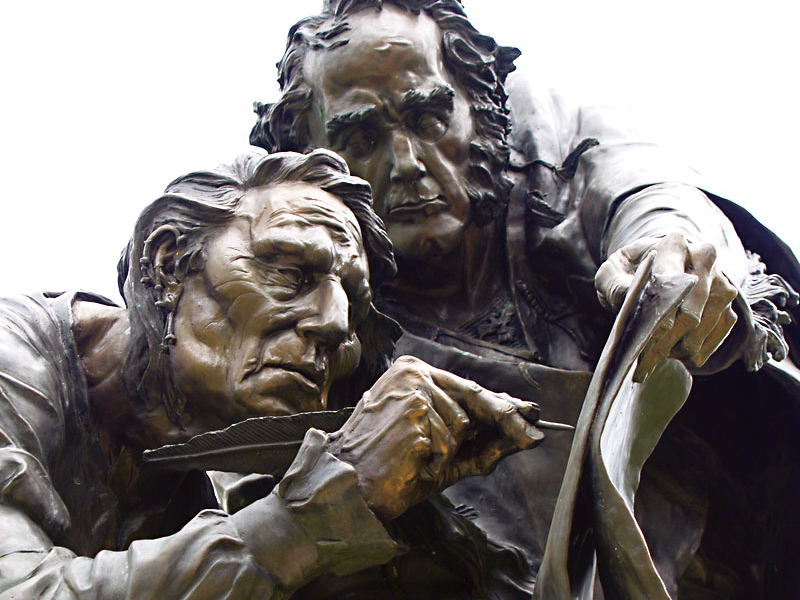By Tom Geddie
As people gather in the woods between Tyler and Edom July 13 to remember one of the most horrific days in the history of East Texas, the crowd will include descendents of the Cherokee leader slaughtered, along with much of his family and 800 other native Americans.
That was 174 years ago in what is known as the last battle between the Cherokees and whites in Texas.
Chief John “Duwa’li” Bowles, Chief Big Mush, six other tribal chiefs, the warriors, and many women and children from as many as a dozen affiliated tribes were killed July 16, 1839. Only a few escaped.
Chief Bowles — also known as Duwali, Diwal’li, Chief Bowl, Colonel Bowles, Bold Hunter, and the Bowl — was the principal chief of the Cherokees in Texas. He was born in North Carolina around 1756, the son of a Scottish father and a full-blooded Cherokee mother. He moved his people several times to avoid the encroaching Caucasian settlers and tried to get a land grant from the Mexican government before the Texas revolution, eventually getting a Texas grant from Sam Houston. The Republic of Texas invalidated that grant and President Mirabeau B. Lamar ordered him and his people to leave Texas. After negotiations failed, Bowl mobilized his warriors — including Cherokee, Shawnee, Delaware, Kickapoo, Quapaw, Choctaw, Biloxi, Ioni, Alabama, Coushatta, Caddo, Tahocullake, and Mataquo – to resist expulsion.
The annual “Battle of the Neches” memorial ceremony is open to the public, drawing a few descendants — nobody knows exactly how many of these there are — as well as a variety of other people, including local historians. It officially begins at 4 p.m. with storytelling, food, and native American crafts, with the ceremony beginning at 6:30 p.m. Many people come earlier and stay later, some staying overnight. Some wear traditional clothing.
One of the people who attends is Blake Fulgham of Brownsboro, who works in his father Joe Fulgham Jr.’s dental office and has his own landscaping business, Duwali Landscaping, named for his ancestor and the concept of taking care of the land. Fulgham’s grandmother’s maiden name was Boles (The “w” was removed at some point, most likely when county clerks wrote the way it sounded).
“We’re direct descendants of him, through a series of ‘greats,’” Fulgham said.
“There will be a smudge ceremony, with the sage smoke to cleanse the spirit and push away evil spirits,” he said. “There will be corn meal and sacred tobacco — grown only on reservations by the Indians, a practice that’s probably thousands of years old— to help them get to the spirit world.”
Some of Fulgham’s ancestors escaped when Chief Bowles, knowing defeat was coming and that the Texas army was focused on him, went out front to draw fire.
Stories passed down through the family focus more on who Chief Bowles was, as a person, than on the details of the battle itself.
“The stories passed down by the family, a lot of them were kinda toned down,” Blake said. “More told what kind of person he was, bold but kind and generous. He fought for his family. That’s the main story you get from the family.”
“It means a lot to know where you come from, who you are as a person, your history, your ancestors,” he said. “To know that he stood up for what’s honorable, what’s good. That’s the most important thing in my own life, to protect my daughter, to protect my family, to make sure they are safe. That’s the biggest thing there is, to put other people before yourself. To know that’s in my family reaffirms that other people in my family are more important, and to do everything I can to make sure they are safe. That’s who I am.”
Fulgham said he believes the whole battle could have been avoided with a little patience from the Texas army.
“He (Chief Bowles) asked if they could wait until after harvest time, which was pretty close. They wanted to wait until at least August to harvest their crops,” Fulgham said. “They had been on the Trail of Tears before and many died. He knew if they walked from here to Oklahoma they would die without food, so they didn’t really have a choice: die on the trip or defending themselves. Some of the younger chiefs wanted to fight. Chief Bowles never wanted to fight, but they all came to him and pleaded their case at the council.”
Historical accounts say the battle began on July 15. The next day, Chief Bowles, who was 83 years old, signaled retreat but he was shot in the leg and his horse was shot in the back. He sat, crossing his arms and legs facing the company of militia, and the militia captain put his pistol to Chief Bowles head and killed him. The body was mutilated and left where it lay.
The state erected a simple marker on the remote site, near the Neches River, in 1936.
The American Indian Cultural Society, which now owns the property, has a different view which they tell in their own marker.
“We have personally taken on the responsibility of preservation and maintaining this sacred ground, helping to preserve it as a memorial and sanctuary for all who wish to honor and respect the ancient traditions, beliefs, and customs of all American Indian people,” said Sondra McAdams of the American Indian Cultural Society (AICS). “This place is now and forever considered sacred ground by many. The spirits of the men, women and children slain there can still be felt. Their blood and tears forever stain the land.”
The master of ceremonies is Eagle I, chairman of the AICS.
The site is off Van Zandt County Road 4923 2.4 miles off Highway 64 12 miles west of Tyler, and is marked by signs.
For more information, go to www.powersource.com/cherokee/ancestor.html.


